BBC Information, Accra
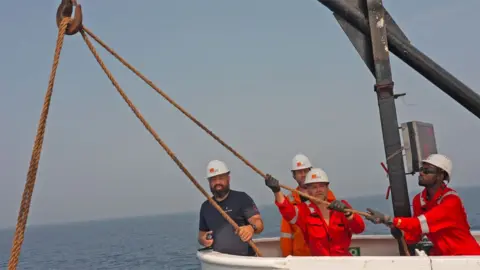 BBC
BBCA boat the scale of a soccer garden, crewed via greater than 50 engineers and technicians, cruises the oceans round Africa to secure the continent on-line.
It supplies an important provider, as extreme week’s web power outage confirmed when web cables buried deep underneath the ocean have been broken.
Hundreds of thousands from Lagos to Nairobi have been plunged into virtual darkness: messaging apps crashed and banking transactions failed. It left companies and people suffering.
It was once the Léon Thévenin which fastened the more than one cable screw ups. The send, the place a BBC workforce not too long ago spent a future on board off the coast of Ghana, has been doing this specialized restore paintings for the extreme 13 years
“Because of me, countries stay connected,” Shuru Arendse, a cable jointer from South Africa who has been operating at the send for greater than a decade, tells the BBC.
“IT people at home have work because I bring the main feed in,” he says.
“You have heroes that save lives – I’m a hero because I save communication.”
His delight and keenness replicate the sentiment of the professional workforce at the Léon Thévenin, which stands 8 flooring prime and carries an collection of kit.
The web is a community of computer systems servers – to learn this newsletter it’s most probably that no less than certainly one of 600 tale optical cables the world over gathered the information to offer it for your display.
These kind of servers are in information centres outdoor of Africa and the tale optical cables run alongside the sea ground linking them to coastal towns at the continent.
Knowledge travels via hair-thin fibreglass wires, incessantly grouped in pairs and secure via other layers of plastic and copper relying on how alike the cables are to the shore.
“As long as the servers aren’t in the country, you need a connection. A cable runs from one country to the next, linking users to servers that store their data – whether it’s accessing Facebook or any other online service,” says Benjamin Smith, the Léon Thévenin’s deputy leading of project.

Undersea tale optical cables are designed to paintings for 25 years with minimum upkeep, but if they’re broken, it’s generally because of human task.
“The cable generally doesn’t break on its own unless you’re in an area where there are pretty high currents and very sharp rocks,” says Charles Heald, who’s in command of the send’s remotely operated car (ROV).
“But most of the time it’s people anchoring where they shouldn’t and fishing trawlers sometimes scrape along the seabed, so typically we would see scars from trawling.”
Mr Smith additionally says herbal screw ups motive injury to cables, particularly in portions of the continent with ultimate climate statuses. He offers an instance of the seas off the coast of the Democratic Republic of Congo, the place the Congo River empties into the Atlantic.
“In the Congo Canyon, where they have a lot of rainfall and low tide, it could create currents that damage the cable,” he says.
Planned sabotage is tricky to spot – however the Léon Thévenin workforce say they now not noticeable any visible proof of this themselves.
A week in the past, 3 essential cables within the Crimson Sea – Seacom, AAE-1 and EIG – have been severed, reportedly via a boat’s anchor, disrupting connectivity for thousands and thousands throughout East Africa, together with Kenya, Tanzania, Uganda and Mozambique.
Only a era then, in March 2024, a detached poised of breaks within the Wacs, Ace, Sat-3, and MainOne cables off the coast of West Africa brought about vile web blackouts throughout Nigeria, Ghana, Ivory Coast and Liberia.
The rest that required the web to serve as felt the tension as upkeep stretched on for weeks.
Nearest in Might, but any other setback: the Seacom and Eassy cables suffered injury off the coast of South Africa, hitting connectivity in more than one East African international locations as soon as once more.
Such faults are detected via trying out electrical energy and sign power transmitted via cables.
“There may be 3,000 volts in a cable and suddenly it drops to 50 volts, this means there’s a problem,” explains Loic Wallerand, the send’s leading of project.

There are native groups with the capability to offer with faults in shallow waters, but when they’re detected past a intensity of 50m (164ft), the send is named into motion. Its workforce can healing cables deeper than 5,000m under sea stage.
The restore witnessed via the BBC off Ghana took over a future to offer with, however maximum web customers didn’t realize as visitors was once redirected to any other cable.
The character of each and every restore will depend on the a part of the cable this is broken.
If the fibreglass on the core breaks, it manner the information can not advance alongside the community and must be despatched to any other cable.
However some African international locations have just one cable serving them. This implies a cable broken this fashion leaves the affected segment with out the web.
At alternative occasions, the protecting layers of the tale may well be broken, which means information transmission nonetheless happens, however with a decrease potency. In each circumstances, the workforce will have to in finding the precise location of the wear.
On the subject of damaged fibreglass, a bright sign is shipped in the course of the cable and thru its level of mirrored image, the workforce can decide the place the fracture is.
When the disease is with the cable’s insulation – referred to as a “shunt fault” – it turns into extra sophisticated and {an electrical} sign needs to be despatched alongside the cable to bodily monitor the place it’s misplaced.
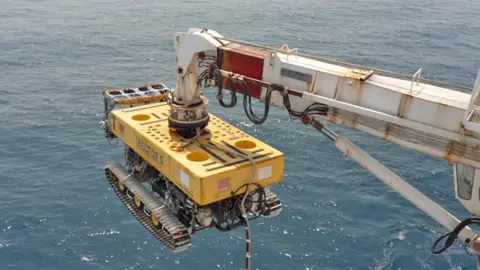
Nearest narrowing indisposed the imaginable segment for the fault, the operation strikes to the ROV workforce.
Constructed like a bulldozer, the ROV, weighing 9.5 tonnes, is diminished underneath H2O from the send the place it’s guided right down to the sea ground.
About 5 workforce contributors paintings with a crane operator to deploy it – as soon as it’s immune from its harness, referred to as the umbilical wire, it floats gracefully.
“It doesn’t sink,” says Mr Heald, explaining the way it makes use of 4 horizontal and vertical thrusters to go in any course.
The ROV’s 3 cameras permit the workforce boarded to search for the correct location of faults because it strikes to the sea mattress.
As soon as discovered, the ROV cuts the affected phase the use of its two palms, after ties it to a rope this is dragged again to the send.
Right here the misguided category is distant and changed via splicing and becoming a member of it to a fresh cable – a procedure that appears like welding and which took 24 hours relating to the operation witnessed via the BBC.
Afterwards the cable was once in moderation diminished again to the sea mattress and after the ROV made one ultimate travel to check out that it was once neatly positioned and pluck coordinates so maps may well be up to date.
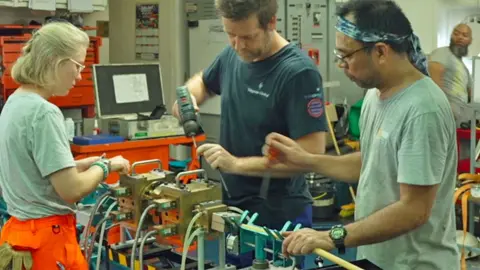
When an alert is gained a couple of broken cable, the Léon Thévenin workforce is able to sail inside 24 hours. Alternatively, their reaction week will depend on a number of components: the send’s location, the provision of backup cables and bureaucratic demanding situations.
“Permits can take weeks. Sometimes we sail to the affected country and wait offshore until the paperwork is sorted,” Mr Wallerand says.
At the moderate, the workforce spends greater than six months at sea each and every week.
“It’s part of the job,” says Captain Thomas Quehec.
However chatting with the workforce contributors between duties, it’s crispy to forget about their private sacrifices.
They’re drawn from other backgrounds and nationalities: French, South African, Filipino, Malagasy and extra.
Adrian Morgan, the send’s leading steward from South Africa, has overlooked 5 consecutive marriage ceremony anniversaries.
“I wanted to quit. It was difficult to stay away from my family, but my wife encouraged me. I do it for them,” he says.
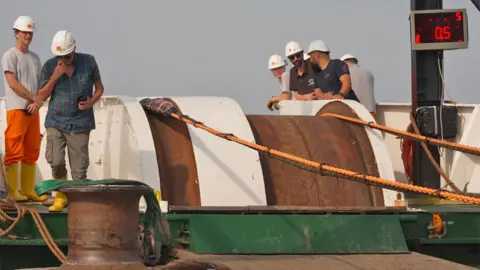
Every other South African, upkeep more healthy Noel Goeieman, is anxious he would possibly omit his son’s marriage ceremony in a couple of weeks if the send is named out to any other project.
“I’ve heard we might go to Durban [in South Africa]. My son is going to be very sad because he doesn’t have a mum,” says Mr Goeieman, who misplaced his spouse 3 years in the past.
“But I’m retiring in six months,” he provides with a grin.
Regardless of the emotional toll, there may be camaraderie boarded.
When off-duty, workforce contributors are both enjoying video video games in the living room or sharing foods within the send’s mess corridor.
Their access into the occupation is as numerous as their background.
Month Mr Goeieman adopted his father’s footsteps, leading cook dinner, South African Remario Smith, going to sea to departure a generation of crime.
“I was involved in gangs when I was younger,” Mr Smith says, “My child was born when I turned 25, and I knew I had to change my life.”
Just like the others boarded he’s appreciative of the position the send performs at the continent.
“We are the link between Africa and the world,” says leading engineer Ferron Hartzenberg.
Alternative reporting via Jess Auerbach Jahajeeah.
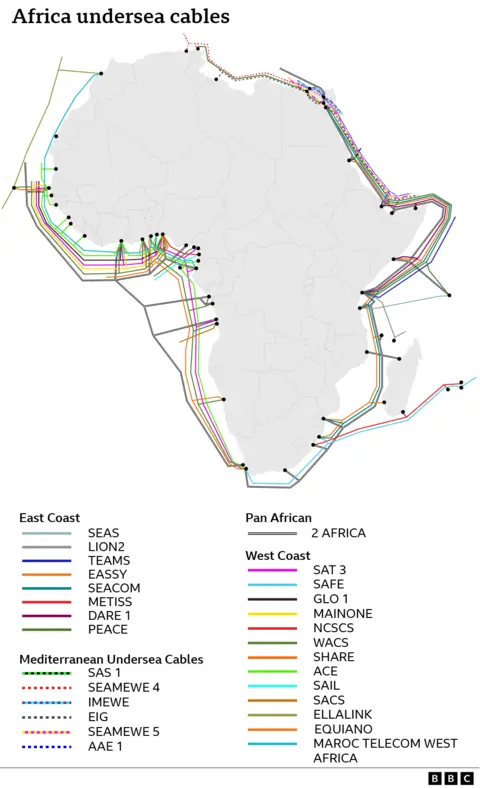
You might also be serious about:
 Getty Pictures/BBC
Getty Pictures/BBC